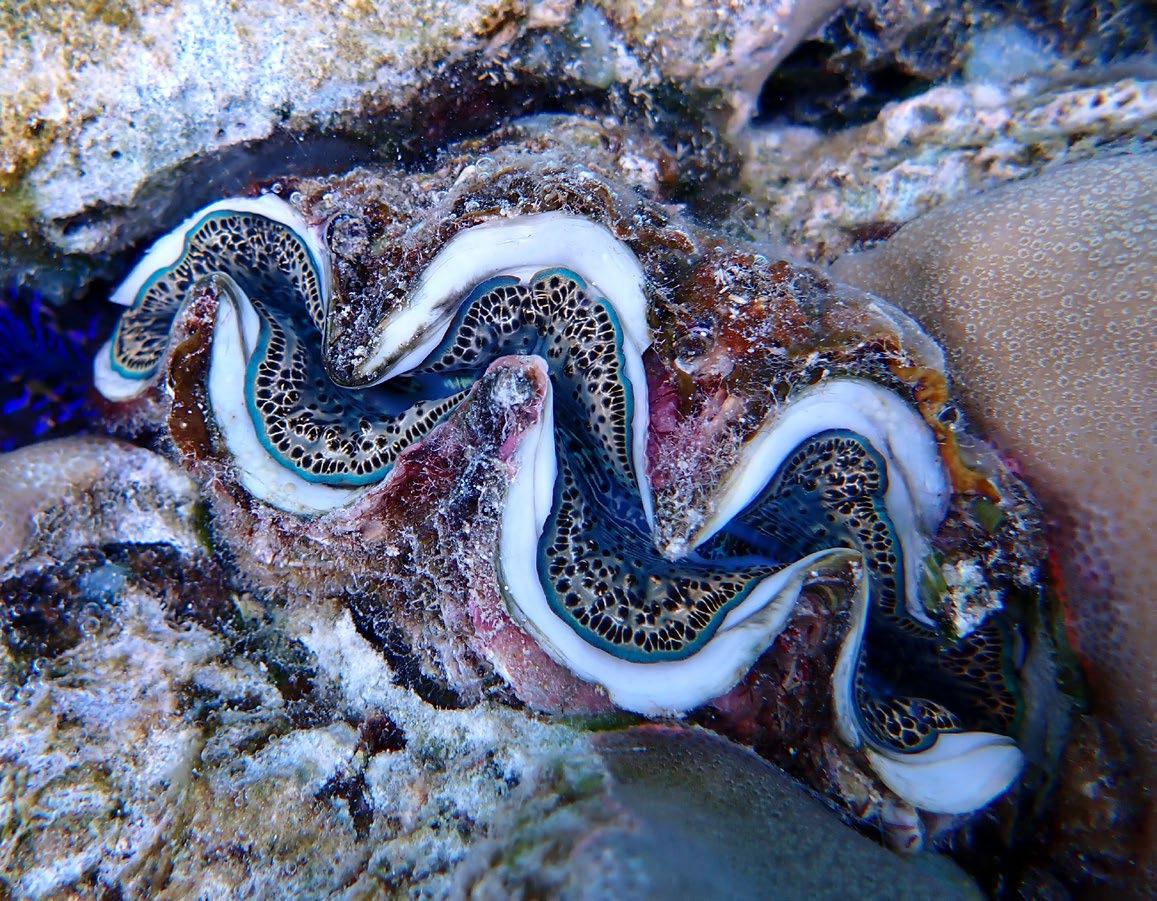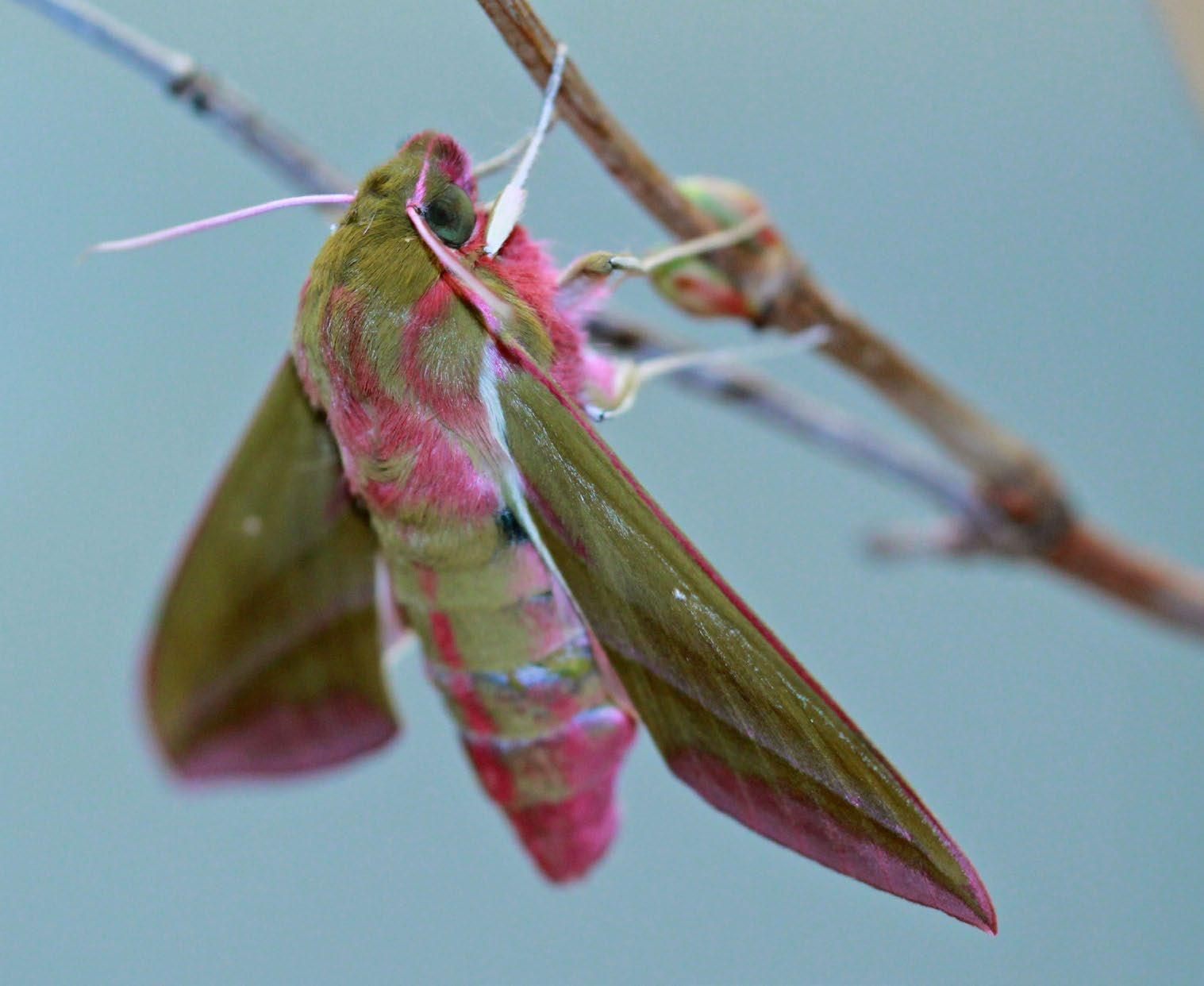
11 minute read
LIGHT OF THEIR LIVES
BY ALEX EVANS
The evolution of animal life on Earth has been fundamentally driven by the Sun – not only as our greatest source of heat, but also of natural light. Physiology, biochemistry, community ecology and behaviour are just some of the key aspects of life that are affected by the presence or absence of illumination, so let’s shine a light on some recent research into the world of animal–light interactions.
Bumbling Bees
Our world is lit by sunlight that animals rely on to find their way around—but the levels of sunlight available vary dramatically depending on when and where an animal finds itself. Performing essential tasks such as looking for food can become quite challenging in low-light environments, especially for animals that rely on flight. Lana de Vries, a PhD candidate at the Experimental Zoology Group of Wageningen University & Research, is currently conducting research on the foraging behaviour of bumblebees and the role that their visual system plays during landing.1 ‘I am interested in understanding the way different animals think, and a good way to study that is looking at their behaviour,’ says Lana. ‘I think insects are especially fascinating because they are so different from us, and by studying the landing behaviour of bumblebees, I’m trying to learn something about the way their brain works.’
As Lana says, understanding the visual systems of animals requires more than just looking at the eyes, you need to explore the secrets of the brain too. ‘Lately, several studies have shown that bumblebees are more intelligent than we thought previously, which makes them a fascinating study species,’ she explains. ‘I also use their intelligence by training the bumblebees to do the things I need them to do in my experiments.’
Recently, Lana’s research has focused on the role that light plays in the landing behaviour of bumblebees. ‘I look at the effect of the light spectrum on their landing performance and at how well bumblebees land on moving flowers in different light intensity levels.’ When bumblebees forage, they fly from flower to flower and often have to land on moving surfaces. Their ability to do this successfully and using as little energy as possible depends on their ability to see their target, which itself depends on the light that is available. ‘They need to be able to do this in a large range of light conditions, since the light intensity and spectrum can vary a lot during the day,’ she says. ‘In addition, bumblebees are nowadays often used in greenhouses for the pollination of plants and, inside greenhouses, light intensity levels are often lower than outside and the light spectrum is sometimes manipulated to increase plant growth.’2
To determine how the bumblebee’s flight performance is affected by the light, Lana and her team developed an experimental setup that allowed them to film landing behaviours on moving artificial flowers. To convince the bumblebees to land on them required a bit thought. ‘We came up with the idea of a moving artificial flower with a small hole in the middle, through which the bumblebees would be able to crawl.’ After training the bumblebees to fly towards the flower, land on it and crawl through the hole, they filmed the experimental landings and tracked the movement of the bumblebees using five cameras.
While analysis of her experiments is still ongoing, Lana has a few ideas on the insights that might be in store for her. ‘I would expect that bumblebees will be better able to land on a moving flower if the light intensity is high rather than when the light intensity is low,’ she says. ‘It will, however, be interesting to see how much their ability to land will decline in low-light conditions, given that they generally deal remarkably well with a decrease in light intensity.’ She adds that she is also interested to see if the bumblebees slow down or alter their landing approach flights in low-light conditions to maximise their chances of success with restricted vision.
Expanding on this topic, Lana would like to see how light pollution may affect their behaviour.
‘Knowledge about the behaviour and ecology of night-active insects is still more limited than the knowledge on day-active insects, and light pollution can have large effects on their behaviour, and therefore their fitness,’ she concludes. ‘I would be interested to find out more about the effects of light pollution on insect behaviour and ecology, and to maybe contribute to solutions to decrease these negative effects.’
Symbiotic In The Aquatic
Above The artificial flower with a hole for the bumblebees to enter Photo credit: Lana de Vries
Photosynthesis is not traditionally a phenomenon associated with animals, but there are a number of animal species that have formed relationships over evolutionary time with organisms capable of harvesting sunlight. One such group of animals is the giant clams (genus Tridacna), who have developed an interesting symbiosis with unicellular algae (zooxanthellae) that can generate food for their hosts in nutrient-poor waters’. In some cases, the algae provide the majority of a clam’s nutrition. However, this useful relationship can also be an unstable one, as Eric Armstrong, an environmental physiologist at the Université de Perpignan Via Domitia in France, explains.
‘I’m working with a large group of international scientists as part of the Tara Pacific Expedition to investigate how reef-building corals and clams across the Pacific Ocean are adapting and responding to climate change,’ explains Eric. ‘My primary area of research is environmental physiology and I’m particularly interested in understanding how ocean warming and acidification affect tropical photosymbionts (giant clams and corals) and intertidal species.’3
Below Tridacna maxima giant clam in Moorea (French Polynesia)
Photo credit: Emily Lam (UC Berkeley)

Eric’s interest in giant clams started as a result of a research internship he participated in with Richard Hill at the Michigan State University.
‘Our goal was to examine the role that certain secondary metabolites played in maintaining the symbiosis between reef-building corals and giant clams,’ he says. ‘From there, I fell in love with the marine realm and its prospects as a study system.’
Now, Eric’s research is helping us to understand how clams maintain this symbiosis in the face of fluctuations in their natural environment. ‘In the marine environment, bicarbonate is the primary form of carbon that is available for photosynthesis by the algae within the clams; however, they actually prefer CO2 as a carbon source,’ he says.
One area of Eric’s research has focused on a hostderived protein, vacuolar-type H+-ATPase (VHA), which plays an important role in the processes that convert bicarbonate into the preferred CO2 to increase the productivity of the microalgae, which in turn maximises their photosynthetic production. To determine the full extent that these VHAs play in this symbiotic relationship, Eric and his team have used both molecular and whole organismal methods in their research.4 ‘At the cellular level, I use immunohistochemical staining to determine where certain proteins are located within a cell, which can give clues as to what functional role they play,’ he explains. ‘At the whole organism level, I rely on respirometry to examine the balance between photosynthetic production and respiration within a given host.’ Using this combined approach has allowed Eric to get a more complete picture on the role of VHAs within marine photosymbionts, from their placement within the cell to their activity within the whole animal.
The results of Eric’s study show that VHAs are actually present in all tissues they sampled throughout the clams, but were much more abundant in the mantle where the algae were situated. By inhibiting VHAs, they found that photosynthetic production dropped by almost half—further highlighting the importance they play for both clams and symbionts. ‘I was surprised by the extent to which VHA has been convergently exapted across marine species,’ says Eric. ‘In reef-building corals and giant clams, VHA has been recruited as a carbon pump to promote photosynthesis, but it has also been discovered to play roles both in skeletal formation and in carbonate dissolution—VHA is truly a multipurpose protein!’
Eric’s next steps include investigating whether photoprotective secondary metabolites actually help to mitigate light stress, and if their expressions can be modified by the clams in response to changing environmental conditions. ‘I’d also like to perform a more quantitative examination of the contribution of giant clam acid secretion to reef bioerosion and examine whether liberated carbonate from acid etching is reutilised by the giant clam host or its microalgal symbionts,’ he concludes.
Hawkestral Manoeuvres In The Dark
Animal vision is a fascinating sensory adaptation, without which many animals would be unable to navigate their environment to find food, shelter or mates for reproduction. Processing light into a rich tapestry of information may be something we take for granted, but light doesn’t simply exist in an on-or-off state and different animals are accustomed to different levels of light, with some capable of performing impressive feats of survival at the lower limits of this continuum. Anna Stöckl, a vision researcher at the University of Konstanz and Fellow of the Zukunftskolleg, tells us more about how hawkmoths function in low-light landscapes.
‘In my last year of school we learned about the mechanisms by which the human retina extracts information from the visual world,’ she remembers. ‘There is a network of neurons that extract certain types of information, discard others, and thus lead to a selective perception of the world.’ From here, Anna became interested in not just human vision, but the diverse spectrum of sight for other animals, including some of the smaller animals on the planet. ‘I research fundamental principles of vision in insects,’ she says. ‘Understanding how insects successfully master many of the same challenges that animals with larger brains do provides very insightful comparisons with larger brains.’
One of Anna’s focuses within this field has been an exploration of the neural processing that enables nocturnal moths to see (and see well enough to fly) in low-light conditions, including those produced solely by starlight. By analysing the behaviour of the nocturnal elephant hawkmoth (Deilephila elpenor) when attempting to suckle nectar from moving flowers, Anna and her team were able to evaluate their flower-tracking performance at different light levels. ‘It was very noticeable that the animals were worse at tracking the flowers at the brightest light intensities such as sunset, compared to the dimmest light such as starlight,’ explains Anna. ‘This was unlike other species of moths, even crepuscular-nocturnal ones, which tracked flowers with higher precision in brighter light intensities.’
Intrigued by this result, the team delved into the neurophysiology of the elephant hawkmoth but found that their visual neurons actually responded similarly to both the higher and lower light intensities, leading the team to suggest that this may be linked to taking the moths out of their flying comfort zone. ‘The impaired flower tracking at higher intensities might be a result of the moths’ internal state, much like when you wake us in the middle of the night,’ she says. ‘Making moths fly outside of their nocturnal phase might be leading to more sluggish behavioural control.’ Anna’s research not only demonstrates the complex interactions between an animal’s anatomy, neurobiology and their internal state, but also raises new questions about the effects that anthropogenic light sources at night may have on low-light specialists such as the elephant hawkmoth. ‘In the near future, we want to understand how flexible the visual system of insects can be to changes in light,’ she says. ‘While the overall light level differs drastically from day to night, this change is very gradual, but light levels can also change rapidly when nocturnal animals fly close to an artificial light source at night.’ Unlike humans and other vertebrates, insects don’t have the rapid pupil mechanisms that regulate light influx to the eye and instead have to rely on neural mechanisms, leaving much that we still don’t know about how insect vision will fare in an increasingly well-lit world.
Looking On The Bright Side
As the famous adage tells us, too much of a good thing can be a bad thing, and light is no exception. Much of the animal kingdom has developed some type of biological mechanism for sensing and interpreting light in the visible or near-visible spectrum, but with continued exposure to light at high intensities, these finely tuned mechanisms can become damaged or even permanently disabled. In a world with a changing environment and increasing pollution from artificial light sources, what impacts can we expect changes in light intensity to have on organisms? Thankfully, Martta Viljanen, a researcher at the Norwegian University of Science and Technology in Trondheim, Norway, is on the case.
‘My main research area is visual ecophysiology and I am specifically interested in how aquatic animals are adapted to different light environments,’ she explains. ‘I also have a soft spot for weird taxa and non-model organisms.’ When she was looking for a topic for her master’s thesis, she was presented with an opportunity to study the visual physiology of a glacial relict opossum shrimp (Mysis relicta) in different light environments, and she eventually continued this research through into her PhD.5 ‘Visual systems of aquatic animals provide a great approach for studying adaptation and acclimation, because underwater light as an environmental factor and artificial light as experimental stimulus are easily measurable and their effects on physiology and behaviour quantifiable,’ she adds.
Animals become acclimated to performing certain actions, including foraging and sleeping, at certain light levels, but interference from humans can affect the timing and intensity of these levels and disrupt the natural stimuli that these animals rely on, exposing them to light-induced damage. ‘Our results show that not only is the light exposure history crucial for the emergence of light-induced morphological and functional changes in the crustacean eyes, but also the timeframe they are presented in,’ says Maarta. ‘It seems that the adaptive mechanisms are functioning at time scales present in nature, which should be taken into account when, for example, planning laboratory studies on animals caught in dim light environments.’
To fully examine how light is absorbed in these crustaceans, Martta and her team have adopted a full-spectrum approach from molecular methods up to animal behaviour analysis, while also considering the evolutionary and ecological context of these changes. ‘The molecular level includes studying the genes coding opsins (proteins in visual pigments) and their expression in the eyes,’ she says. ‘These are the molecules actually catching the photons and thus responsible for the first steps in vision.’ Scaling up to the cellular and organ levels, Martta also studies the spectral sensitivity of eyes with a microspectrophotometer, which allows them to measure light absorption for single cells, and electroretinography, which allows her to record electrical responses to an array of light stimuli at the across the whole eye. Together, these techniques provide invaluable insights into how light is processed by the eyes, especially when there is too much to absorb safely.
Visual Systems Of
From the results of her work with collaborators at the Moscow State University,5 Martta was surprised to see that light-induced damage in the eyes of these crustaceans can actually take several weeks to recover from. ‘This is again something to consider when planning and conducting experiments,’ she explains. ‘For many marine invertebrates it has been quite common practice to let them dark acclimate 24 hours after a light exposure before any experiments related to visual functions, but if some damage has taken place this might be way too short a time.’ More recently, Martta has been involved in a project called LightLife,6 where she is studying the photobiology of plankton in the Arctic and Northern waters to assess the dynamic range of vision on zooplankton species and the role played by light-induced damage. ‘Part of this work is carried out during the polar night when the zooplankton has been shown to react to extremely small changes in the ambient light levels,’ she concludes.
CAN ACTUALLY TAKE SEVERAL WEEKS TO RECOVER FROM.
Reference:
1. https://www.wur.nl/en/project/Visual-system-ofbumblebees-1.html
2. De Vries LJ, Van Langevelde F, Van Dooremalen C, et al. Bumblebees land remarkably well in red–blue greenhouse LED light conditions. Biol Open 2020; 9: bio046730.
3. https://www.armstrongecophys.com/giant-clam-physiology
4 Armstrong EJ, Roa JN, Stillman JH, et al. Symbiont photosynthesis in giant clams is promoted by V-type H+ATPase from host cells. J Exp Biol 2018; 221: jeb177220.
5. Feldman T, Yakovleva M, Viljanen M, et al. Dark-adaptation in the eyes of a lake and a sea population of opossum shrimp (Mysis relicta): retinoid isomer dynamics, rhodopsin regeneration, and recovery of light sensitivity. J Comp Physiol A 2020; 206: 871–889.
6. https://www.instagram.com/lightlife_project/
Opposite Page Elephant hawkmoth Photo credit: Anna Stockl











